Some words in Santander carry a burden of sadness about them and one of the saddest must be the word Machichaco. 600 people died and 2,000 were injured in Santander’s port in 1893 as a result of two explosions that went off on board a ship named ‘Cabo Machichaco’.
Last Saturday, a number of associations including my rowing club, Santander en Boga, joined forces to mark the anniversary of the tragedy. We had originally planned to row a few traineras to the site of the disaster but the strong southerly winds prevented that. No harm done – we swapped our wet gear for our finery and hopped aboard a boat in Puertochico to retrace the final steps of that fateful journey.
The Lead-up to the Tragedy
Pedro Blanco, the city’s expert on the event, and Vice-President of the Royal Machichaco Association, talked us through the history of the boat and the sequence of events that occurred back in 1893 as we travelled around the bay.
With our stern to the city centre and our bow towards Pedrosa, we learned that the Machichaco or Benisaf as it was first known, was built in Newcastle in 1882 for a French company. A couple of years later, it was purchased by Compania Ybarra, a shipping company that handled deliveries from Bilbao to Seville and onto ports in the Mediterranean. It was re-named Machichaco after the name of a place in the Basque Country.
On its arrival into Santander from Bilbao, the Machichaco was immediately quarantined for 10 days because the Basque city had suffered an outbreak of cholera. The crew and cargo were docked for the duration in nearby Pedrosa. Daily medical visits were carried out and the ship was finally allowed to access Santander on the tenth day.
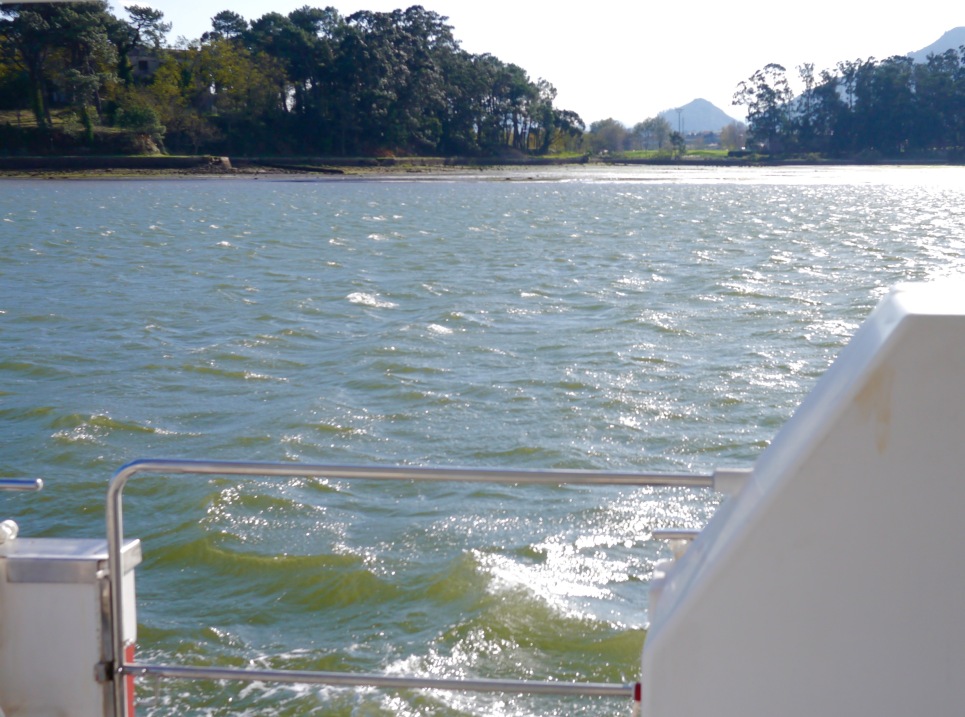
Looking onto Pedrosa where the Machichaco was quarantined for cholera. The hospital on this peninsula was used as a quarantine base up until 1989 when it became a centre for drug dependency.
The port was very busy on the morning the Machichaco was given the all-clear from cholera. Perhaps in recognition of its 10-day delay, the Captain was given clearance to use the city’s central dock. This was the first of many ill-fated decisions that morning. We moored directly opposite the site of the disaster and Pedro continued.
That loading bay was located just off Calle Calderon de la Barca and it was a prime slot right beside the old medieval city centre. This dock should never have been used for a boat with dangerous cargo. But Captain Facundo Léniz Maza hadn’t informed the authorities of the contents of his hull. It seems that the practice at the time was to disclose what was being disembarked at that particular port rather than what was on board.
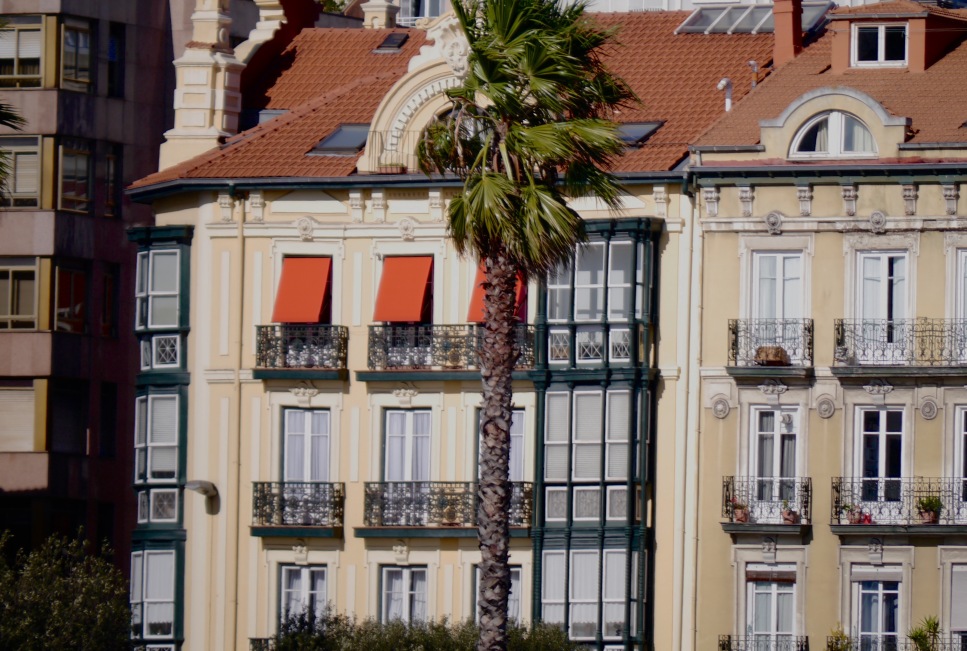
Zooming in on Calle Calderon de la Barca (just behind the Ferry Terminal) to give you a sense of how residential this area was and still is…
The Cargo of the Machichaco
The boat was carrying somewhere in the region of 1,600 tonnes of cargo including iron and other metals in every shape and size from iron bars, tin, and pipes down to nails. It was also carrying flour, wine, spirits, paper, tobacco, wood as well as paint, oils, acids and glass. But the boat’s best kept secret (or worst) was the 51 tonnes of dynamite on board. Only 20 boxes* of dynamite were intended for Santander – the rest was to be delivered to other ports on the ship’s route including Seville. (*You’ll see some variance below in the reporting of the number of boxes of dynamite on board – the estimate is about 1,400).
Unloading the Goods for Santander
The crew started offloading their cargo at 9am. It was reported that a delivery guy with a horse and cart took some time to be convinced to take the dynamite and only agreed to accept it when he was given a police escort to accompany him through the city. As the rest of the merchandise was being unloaded, it seems some irregularities were encountered. Two huge cylinder rolls of paper bound for a connecting ship to Cuba couldn’t be accounted for. There was some to-ing and fro-ing from the deck to the bowels of the ship until the paper coils were found. Shortly afterwards, at around 2pm smoke was seen coming out of one of the ship’s three cargo bays and the fire was reported.
How did that fire start, you must be wondering. Listening to our Machichaco expert, Pedro Blanco, it seems that sulphuric acid on board may have leaked through to where paper or textiles were being stored and this was enough to start off a fire. When the crew raised the alarm, the fire brigade was summoned and crews from other nearby liners and boats were called on to assist in the operation. All the parties worked for hours attempting to put out the flames.
The severity of the situation was acknowledged when the smoke emerging from the ship turned from black to white – which meant it was actually steam emerging rather than smoke. The water being used to put out the fire wasn’t working. Some time around 4.30pm, the decision was taken to sink the ship. Unfortunately, attempts to open the hull by hammering created the necessary vibrations for the dynamite, which was now in its liquid nitroglycerin state and floating on top of the water, to explode. Boom!
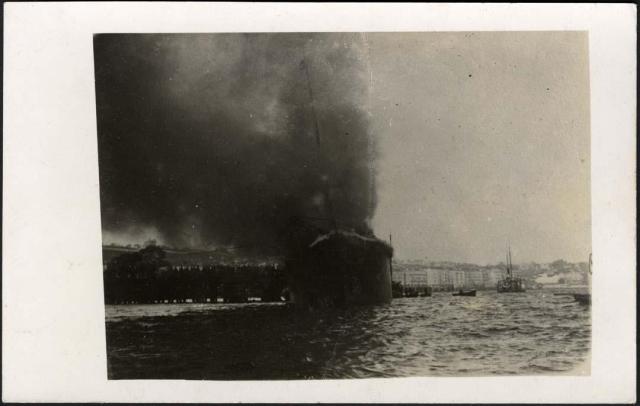
‘The Explosion of the Cabo Machichaco’ by Pablo Isidro Duomarco on 3 November 1893. From the Víctor del Campo Cruz Collection. © Centro de Documentación de la Imagen de Santander. Ayuntamiento de Santander
When the dynamite exploded around 5pm, an enormously heavy wave of water subsumed the immediate dockland area, dragging all it found in its path back into the bay. If that wasn’t bad enough, much of the ship’s contents including those now roasting hot iron bars and all the other iron and metal cargo was flung out from the ship causing significant damage further afield. Some of the iron bars are said to have weighed 300kg a piece so you can imagine the structural damage those caused. Eyewitnesses described the blast as an inverted pyramid shooting out from the ship. (Scroll down this link to see a painting by Tomas Hoya of this very moment). Roofs were smashed and buildings went on fire. The injuries from shattering glass were also significant. 60 buildings were destroyed and 86 damaged.
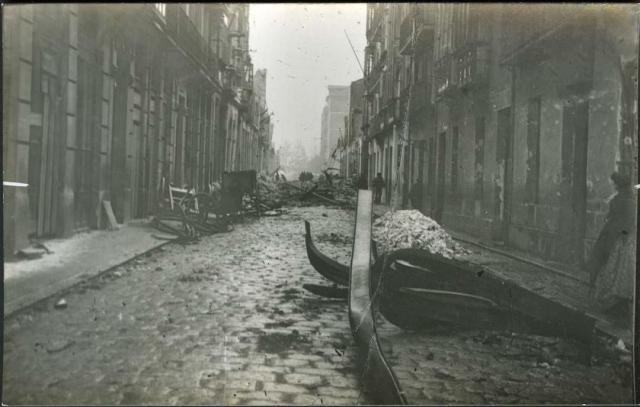
‘The Catastrophe of the Cabo Machichaco’. 3 November 1893. Photographer unknown. The Víctor del Campo Cruz Collection. © Centro de Documentación de la Imagen de Santander. Ayuntamiento de Santander
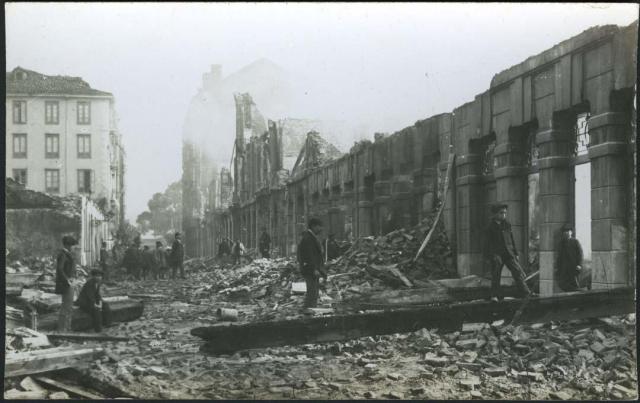
‘The Machichaco Catastrophe on Méndez Nuñez Street’. Photographed by Pablo Isidro Duomarco on 3 November 1893. Part of the Víctor del Campo Cruz © Centro de Documentación de la Imagen de Santander. Ayuntamiento de Santander
The Tragedy within a Tragedy
The unnecessarily high death toll is one of the saddest aspects of this disaster. A high percentage of those who died shouldn’t have been anywhere near the ship. They had no reason to be there. Ignorant of the presence of dynamite or aware but falsely confident of its safety, they were simply standing nearby watching the crews and the fire fighters try to put out the flames.
The city was packed that day. There had been a celebration of a Carlist war in town that morning so all the local authorities were in town in full regalia. When word got out about the flames, the participating authorities went to the dock to help and the attending crowds went to see the spectacle. I’ve read that there were about 3,000 people within 200 metres of the impending disaster so you can understand how 600 were killed and of the 2,000 injured, 500 of those were severely injured. The city’s population at that time was 50,000 so it’s fair to say that every family was personally affected by the blast. I came across an depiction of that scene in a slideshow entitled ‘Disaster and Safety: Images from the Archives of Scientific American’.(The text is very unsympathetic saying the crowds came to “gawp” but I suppose the goal was to prevent the same thing happening again.)
The Immediate Aftermath
When the drama of the fire turned to disaster, those who could walk left the scene immediately. Those who needed medical assistance were taken to the hospital located on the Calle Alta where the Cantabrian Parliament sits today. Those who escaped injury made sure to leave the city centre for fear of further explosions. With a few exceptions, the local population is described as being too paralysed by shock to do anything beyond caring for or identifying their own next of kin.
This would normally not be a problem but for the fact that the local chain of command had been completely immobilised. Many of Santander’s ruling class had been killed, injured or were missing. (As any school child studying this tragedy will tell you, the Governor’s body was never recovered although his walking stick fetched up across the bay.) Twenty of the city’s firemen and forty members of its police force had been killed or seriously injured at the site of the disaster. So the fires blazed in the city until help arrived from the rest of Cantabria and Bilbao and San Sebastian. It took three days for the fires to be put out.
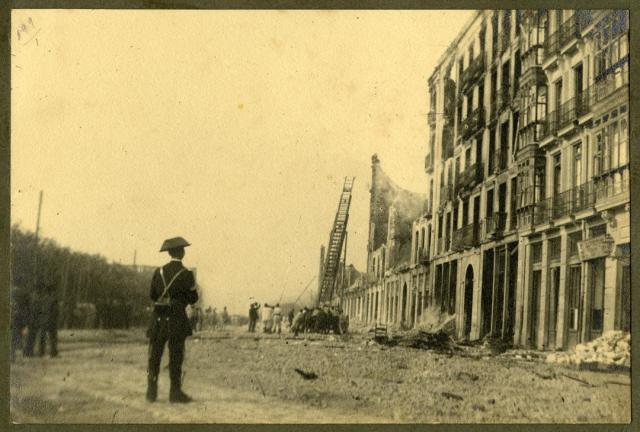
‘The Machichaco Catastrophe on Calderón de la Barca Street’. Photographed by Pablo Isidro Duomarco in 1893. Part of the Víctor del Campo Cruz Collection © Centro de Documentación de la Imagen de Santander. Ayuntamiento de Santander
The Gruesome Task of Identification
If the newspaper reports are to be believed, human remains were to be found everywhere. Divers were paid to remove the bodies from the water – and bodies were still turning up four months after the blast. I found a rather shocking image of such a dive here which was printed in Le Petit Journal in Paris.
The furthest body from the scene was recovered in the Landes region of France. The furthest direct hit happened in Penacastillo, some 6km from the site of the incident, when a man there was killed by flying debris. The furthest remains were found inland of Noja on the other side of the bay; the body part was only identified by the clothing worn. When identification wasn’t possible, the remains were sent to a common grave in the city cemetery at Ciriego.
The Remaining Dynamite
As you’d imagine, there was much consternation locally about what should be done with the boat and its remaining cargo. Divers had found many boxes of dynamite intact. A number of missions took place to remove the dynamite and during one of these efforts on 21 March 1894, a second explosion occurred, killing another 15 people.

‘The Second Machichaco Explosion’. Photographed by Pascual Urtasun on 22 March 1894. Part of the Víctor del Campo Cruz Collection © Centro de Documentación de la Imagen de Santander. Ayuntamiento de Santander
International Coverage
This story was picked up very quickly by the international press. It was so saddening to read of the city in the news for all the wrong reasons. There was no redeeming element to the disaster either in the coverage. No hero to be hailed. Just a city reeling from the tragedy and the horror. As you’ll see below, the shorter articles focused on the more sensational aspects of the disaster. The longer ones tended to question the decision of the captain to withhold information.
The New York Times ran this intro:
THE SANTANDER DISASTER; A THOUSAND PERSONS KILLED, WOUNDED, OR MISSING. The Authorities of the City Paralyzed and Seemingly Unable to Realize the Calamity — A Graphic Description of the Explosion by a Witness Who Escaped Death — Scarcely a Family in the City that Did Not Furnish One Victim to the Disaster.
San Francisco’s The Call went out with (read the piece in full here):
HORRIBLE DETAILS.
Explosion of the Steam ship Machichaco.
Awful work of Dynamite.
Hundreds of People Blown Into Fragments.
THE AIR FILLED WITH DEATH.
Scores Escaped the Explosion Only to Be Swallowed Up by the Sea.
The terrible disaster which wrecked the port of Santander and destroyed hundreds of lives sent a thrill of horror throughout all Spain. Every piece of news which reaches Madrid not only confirms the most sensational reports, but pictures the disaster In more vivid colors than hitherto.
The Sydney Morning Herald covered the clandestine nature of the cargo in its piece:
As we have been informed by cable, a disaster unparalleled in modern times occurred at Santander (Old Castilo) on the afternoon of 3rd November. A Spanish steamer, the Cabo Machichaco, caught fire whilst discharging, alongside the quay, what purported to be a general cargo… It appears (states the Home News), however, that she had also on board over 500 cases of dynamite, which exploded, and spread destruction far and wide. Had a tiny portion of her cargo been declared she would not have been permitted to enter the port, but it appears that the captain declared only 20 cases of the explosive, the remainder, whose clandestine destination is still matter of conjecture, being carefully concealed below.
The Barrier Miner in New South Wales ran a piece with the headline: “A Town Blown to Pieces”. It includes a statement from two survivors (perhaps crew from another boat) who were on board the Machichaco at the time of the explosion and were thrown to sea by blast. They maintain that the Machichaco crew did not know about the additional dynamite on board:
We did not know that there was any dynamite on board the ship beyond the 20 cases which the captain had declared, and which were safely landed on shore when the fire broke out. A few moments before the explosion took place the mate rushed on deck shouting out, “Everybody must leave the ship at once and clear for the quay, for the fire is reaching the dynamite.’ Everybody then made for the gangway, and there was a terrible struggle to get ashore, but the explosion took place before; more than a very few had made their escape. We were thrown with tremendous violence into the sea and, catching hold of a plank, we swam, away from the ship. After a long struggle we reached the shore.
The journalist described the survivors as greatly distressed and overwhelmed by the recollection of their terrible struggle with the waves, which were strewn with corpses and wreckage of every description. Further down the same piece, the paper records damage done to a train nearby.
Another remarkable incident of the catastrophe was the destruction of a local railway train, which, laden with passengers, had just arrived at the station when the explosion occurred. The train was wrecked and ignited, and many of the passengers are reported to have perished.
London’s Spectator tries to give some context to the tragedy and covers before and after the blast in detail. Its article was headlined “The Calamity at Santander”. The quote below relates to the steps taken after the explosion:
Till soldiers and officials arrived, civilised life may be said to have ceased in Santander. The shock had been too severe for the weak organisation called a city, and but for external aid and decisive measures, like the blowing-up of houses, the whole port, which was a flourishing one, being not only a place of lively trade but a pleasure-resort for North-West Spain, might have perished in a day. As it was, hundreds, or more probably thousands, must have perished, in methods which, swift and possibly painless as most of them were, we all feel to be ghastly. The official estimate is now one thousand; but the officials do not know, the desire to minimise is very strong, and the fact that a considerable section of the population was blown from the quay, is confirmed by the divers, who have found the dead bodies in such numbers that, horror- struck, they have refused to continue the task of bringing them up from the water, which the authorities naturally think essential for purposes of identification.
The 1894 Journal for the Society of Engineers in Canada covered the disaster in its entirety. The periodical’s opinion on the danger of dynamite (page 219) is revealing. After evaluating what quantity of dynamite was actually on board the Machichaco at the time of the explosion, the author says:
In an ordinary blasting operation, such as some of those carried out by the author in Jersey, this quantity of dynamite should displace about 200,000 tons of rock.[…] It is a matter for thankfulness that the whole of the 1,700 cases were not exploded, or the results, bad as they were, must have been much worse. […] The doctrine invariably preached and practised by the author is that explosives are only comparatively safe as long as they are treated as absolutely dangerous.
Finally you can read the coverage of the second explosion in 1894 in The New York Times piece which reads:
Angry Mob at Santander; Populace enraged by the Explosion in the Harbor. Loss of Life They Attribute to Carelessness — Governor Forced, to Barricade His Doors with Furniture — Troops Sent to His Relief — Possibility that There May Occur Later on Another Explosion — May Be More Dynamite Under the Water.
Fundraising for the Machichaco at Home and Abroad
I’d hate you to think that those reading the columns and viewing the images were just gorging themselves on the details and then moving on to the next tragedy. The coverage was probably helpful to those who were seeking to raise funds for those affected by the disaster. I came across a blogpost by a Dr Kirsty Hooper at the University of Warwick that highlighted the fundraising for Santander across England. London’s leading Spanish expats not only donated to the cause themselves but they convinced many of the leading locals including the Lord Mayor and the Foreign Secretary to put their hands in their pockets. And it wasn’t just the well-heeled who got involved. A charity football match was organised between Everton’s football team and Liverpool and Manchester pantomime artists. The footballers lost. Read about those fundraising efforts here.
Remembering the Tragedy in Santander
Every year on November 3, a memorial takes places at the monument to the tragedy. As I write these words that memorial has just taken place with the mayor laying a wreath at the foot of the plinth.
As you’d expect, the more significant anniversaries are marked with a number of events and exhibitions. The 120th anniversary in 2013 was a big one. The Provincial Historical Archive of Cantabria (Archivo Histórico Provincial de Cantabria) put together an amazingly detailed exhibition which ran for a few months in the city library. It was called “Ardiendo Machichaco” (Machichaco Burning) after the content of a telegram sent by the crew when the fire broke out. I remember the records on loan from the Red Cross being particularly tough reading. And I recall seeing some of the newspaper cuttings from Spain and abroad that were also very chilling. Unfortunately, I haven’t been able to find any recording of that exhibition but you can see footage from the ‘Inmersión al Cabo Machichaco’ exhibition which took place at the Palacete del Embarcadero in 2013 here.

‘The Monument to the Machichaco in Santander’. Photograph by the Catholic Bookshop taken in 1912. Part of the Víctor del Campo Cruz Collection © Centro de Documentación de la Imagen de Santander. Ayuntamiento de Santander
I wasn’t able to make the formal memorial with the Mayor but I did manage to pop over to the Machichaco monument yesterday morning to pay my respects. It was tricky to get a decent image because the little lane that runs beside the monument was full of delivery trucks stocking up the many bars and restaurants.
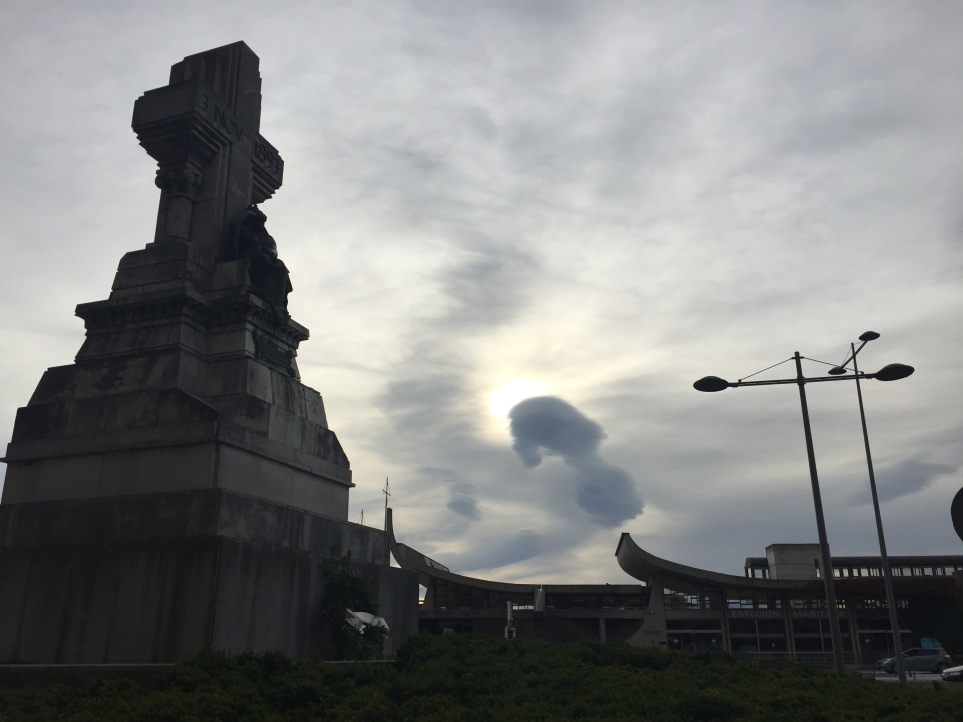
The Machichaco monument with the Ferry Terminal in the background – it was all a bit black and white
After visiting the monument, I went into the bar named after the tragedy, El Machichaco, or El Machi as it is known locally. The city’s wonderful photography archive (from where I sourced the six historic images above) has presented a number of photographs of the disaster to the bars and other businesses in the area so I wanted to see one in situ. And it only seemed fitting to start there…
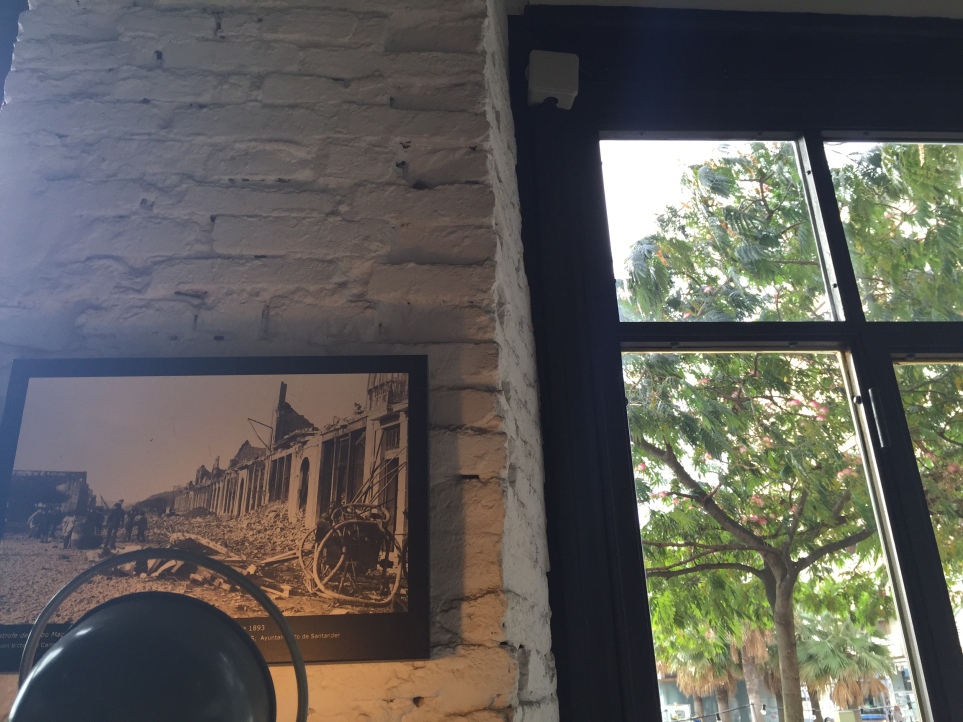
Looking at one of the CDIS images from the Machichaco Tragedy in the Machichaco bar closeby the monument…

I ordered a lovely coffee and took some time to take in the image. And yes, the tortilla caught my eye as well…
Hopefully next year, if the wind behaves itself, we can row and remember those who suffered and lost so much 122 years ago this week…

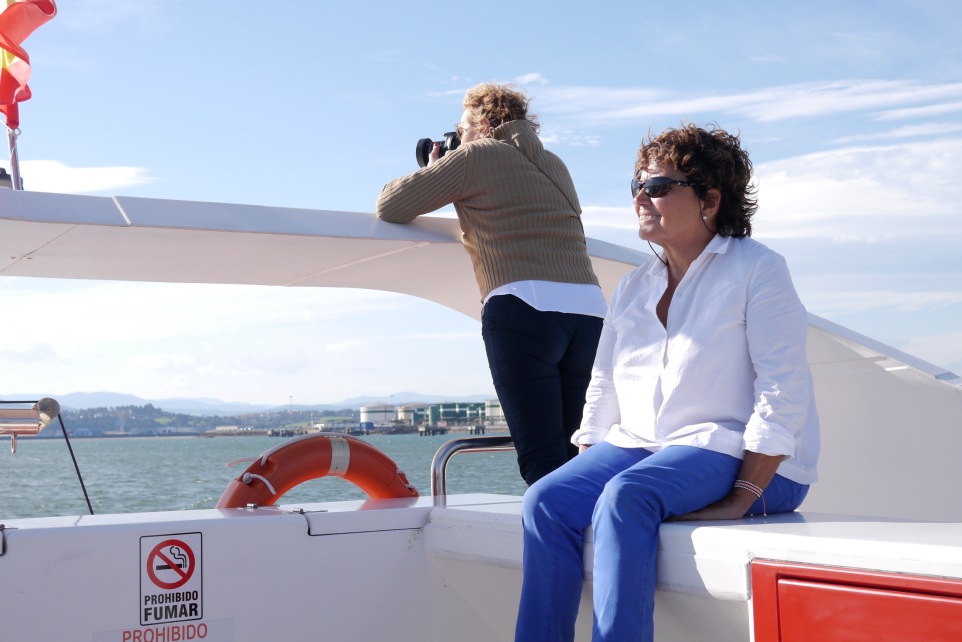



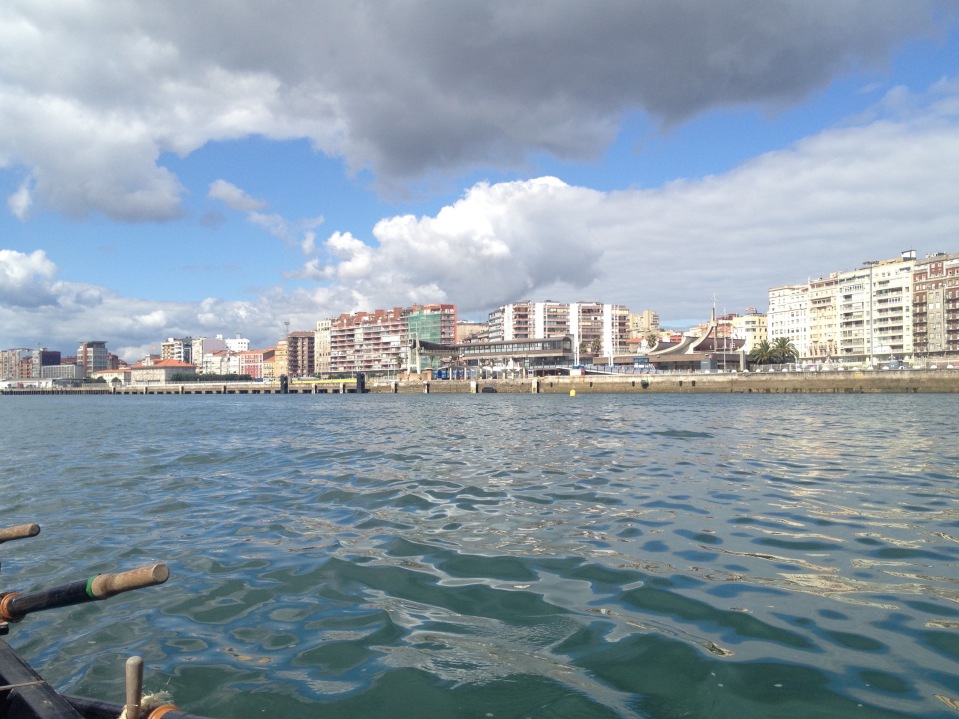
Fascinating article, Pamela!
Thanks Sue. Having heard so much about it over the years, it’s been interesting to research it…
Very well documented – a great read, Pam. Thanks!!
Glad you liked it, Tom. Thanks for stopping by and commenting 🙂
Thanks for this Pamela, I had read of it a few years ago but could not look into it because of my lack of Spanish – whenever I am in the area I am reminded of it and have seen the memorial. Your article is very interesting and informative and sensitive. (I will follow the links as time permits)..
I’m so glad to hear it’s been useful – many thanks for getting in touch to let me know…
Fabulous piece, Pamela. I knew about the disaster having lived in Santander (well Galizano, across the bay) for the past 7 years but your article really brought it home. Hopefully next year hubby and I will make it into the monument for the anniversary. We´ll keep an eye out for you in the water 🙂
Thanks Maria. I know Galizano and I love the beach there. Beautiful coastline. Thanks so much for commenting. I really appreciate hearing what people think. This has been one of the bleakest posts but I felt it had to be included. Hope our paths cross sometime. If you hear an Irish accent on a boat between now and next year – shout out – chances are it’s me 🙂
Thats me she’s talking about Pamela. (The only Ingles in Galizano)
I’ll keep an ear out for an English accent next time I’m over that way then 🙂
What a tragic story, but thank you Pamela for telling it so sensitively. I was surprised to read the Australian press coverage! I hope the weather is calmer for your row next year.
Hi Barbara. Thanks for reading the post 🙂 I was very surprised to read the Australian coverage too! I do hope we manage a nice tribute on the water next year. And for the 125th it would be great to do something extra special! We did get out on the water this weekend and “parked up” on one of the city’s newest ramps to take in the local San Martin de la Mar fiestas which were on all weekend. We were a bit too early for the marching band, the food and the dancing but everybody out for a morning stroll enjoyed seeing our old boat close up including a bride and groom and their photographer. The bride told us her father competed in one of these traditional boats in his youth so she was delighted to happen upon us. So was the photographer who was clicking away merrily. I’m sure her father will be framing up one of those pics!
Hope the course is going really well for you
All my best PamX
Hi Pamela very interesting and well-researched piece. Just one thing puzzled me….how could a body from the explosion be found in France?
Hi Alison. Thanks for reading the post and asking a question. The answer is a bit grim. I don’t know the exact location where the body was discovered but this part of France (Les Landes in French) is only 300km away if you hug the coastline. The person was probably sucked into the water when an enormous wave, created by the blast, flowed back into the bay. The body must have been washed out to sea and was kept there until the currents or tides returned it to ‘terra firma’ on the French coastline.
Unfortunately, this may not be as unusual an event as it might seem. The local newspaper was reporting yesterday that the body of a young fisherman who got into difficulty a week ago was recovered on the Basque coastline about 150km east of here. May he and all the other souls lost at sea, rest in peace, as we say in Ireland.
Hi, Pamela, I just happened to walk pass the memorial yesterday, 17 oct 2016, I didn’t think it was much to write home about, as we Irish say. I later checked the internet and came across your very interesting, informative and detailed report, believe it or not whilst enjoying a vino tinto in “El Machichaco” taberna, so tragic yet new rules may have been enforced because of the immense carnage, and loss of life, RIP. Is mise, Greg, Slan abhaile.
Hi Greg,
I love hearing that my blogposts are useful so thanks so much for letting me know. And what a coincidence that you did your research in the Machichaco bar itself! It’s a nice spot alright and perfect for a drink anytime of the day or night. Hope you enjoy the rest of your time here and any subsequent research leads you to happy upbeat events rather than maritime tragedies! Go raibh maith agat again for dropping by and commenting 🙂
Pamela
Pamela, thank you for replying, sorry I forgot to mention that I was born and raised in Belfast, so I know very much so about maritime tragedies, Greg, Slan abhaile.
Thank you Pamela. A fascinating account of what must have been an horrific event. I was recently in Santander awaitjng the delayed arrival of our ferry when I saw the memorial. Had never heard of this tragedy before.
Thanks for getting in touch Susan – glad you enjoyed learning about the Machichaco – hope the ferry sailing was otherwise uneventful and you’ll be back again sometime to Santander, best regards, Pamela
I see there is a new boat on the Cork Santander route, called Kerry. Has anyone used it?
I don’t like the way that cars are on the open deck especially in bad weather. Getting covered with wet salt is not good for the car. I got the Friday night boat that arrives Santander Sunday morning and there are few options to wash off the salt early on Sunday morning.
Hi Patrick – Thanks for reading my post on the Connemara and commenting here. According to this Northern Irish Ferry website, the Kerry entered into service on 31 October – https://www.niferry.co.uk/new-cork-ferry-in-service/. I haven’t noticed it myself but I will keep an eye out for it from now on. In the meantime, there’s lots of info here about its history and size https://www.niferry.co.uk/stena-egeria.
Regarding the salt/water on the car, it is a bit of surprise, isn’t it? We rinsed off the windscreen and other windows quickly enough upon arrival and found a carwash in due course. I can well imagine that things are pretty quiet on Sunday mornings here in Santander. That said, there are half a dozen 24-hr petrol stations with car-washes in and around the city. I often go to the 24-hr on Avenida de Valdecilla, 14, (beside the hospital) that’s close enough to the exit gates for the ferry – which might suit you next time. It’s one of the roller-tunnel car washes so you won’t be able to clean the under-carriage. If you want a car wash with a high-pressure hose, try the Petrol Station on Calle la Peseta, 1 (Nueva Montaña) which offers a vast range of car-wash options and opens from 7am-11pm.
I also wonder whether it’s possible to request a space for your vehicle that isn’t up on deck. Always worth a try. Thanks again for stopping by here and happy travels.
Best regards,
Pamela
[For anybody new to this blog – Patrick was commenting to my post on taking the Connemara from Santander to Cork which can be viewed here https://pamelacahill.com/2018/09/17/brittany-ferries-cork-santander/%5D